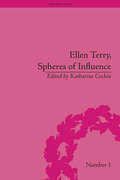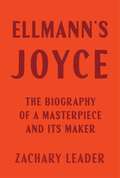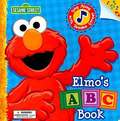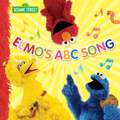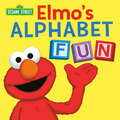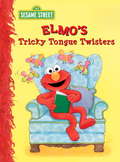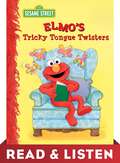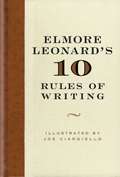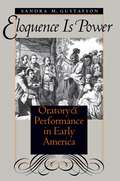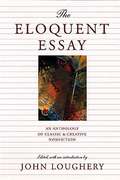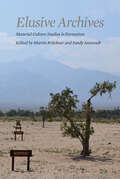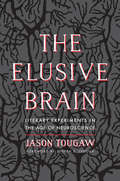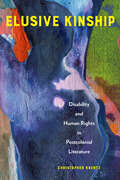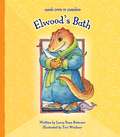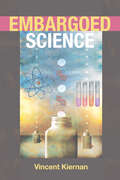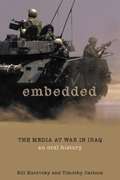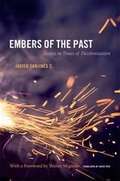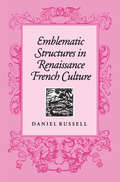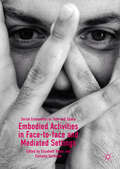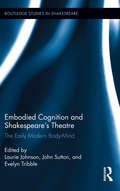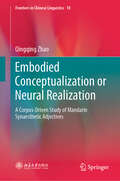- Table View
- List View
Ellen Terry, Spheres of Influence (Dramatic Lives #1)
by Katharine CockinIn this essay collection, established experts and new researchers, reassess the performances and cultural significance of Ellen Terry, her daughter Edith Craig (1869–1947) and her son Edward Gordon Craig (1872–1966), as well as Bram Stoker, Lewis Carroll and some less familiar figures.
Ellipsis in English Literature
by Anne TonerAnne Toner provides an original account of the history of ellipsis marks - dots, dashes and asterisks - in English literary writing. Highlighting ever-renewing interest in these forms of non-completion in literature, Toner demonstrates how writers have striven to get closer to the hesitancies and interruptions of spoken language, the indeterminacies of thought, and the successive or fragmented nature of experience by means of these textual symbols. While such punctuation marks may seem routine today, this book describes their emergence in early modern drama and examines the relationship between authors, printers and grammarians in advancing or obstructing the standardisation of the marks. Their development is explored through close study of the works of major English writers, including Jonson, Shakespeare, Richardson, Sterne, Meredith and Woolf, along with visual illustrations of their usage. In particular, Toner traces the evolution of ellipsis marks in the novel, a form highly receptive to elliptical punctuation.
Ellmann's Joyce: The Biography of a Masterpiece and Its Maker
by Zachary LeaderThe story of the most acclaimed literary biography of the twentieth century—an ingeniously plotted, behind-the-scenes account of how the literary critic and scholar Richard Ellmann shaped James Joyce’s reputation.Richard Ellmann’s James Joyce, published in 1959, was hailed by Anthony Burgess as “the greatest literary biography of the twentieth century.” Frank Kermode thought the book would “fix Joyce’s image for a generation,” a prediction that was if anything too cautious. The biography won the National Book Award and durably secured Joyce’s standing as a preeminent modernist.Ellmann’s Joyce provides the biography of the biography, exploring how Ellmann came to his subject, gained the cooperation of Joyce’s family and estate, shrewdly, doggedly collected vital papers and interviews, placated publishers, thwarted competitors, and carefully balanced narrative with literary analysis. Ellmann’s Joyce also removes the veil from the biographer—richly rewarded in public, admirable in private life, but also possessed of a startling secret life. An eminent biographer himself, Zachary Leader constructs a powerful argument not only in support of Ellmann’s intellectual and artistic claims but also on behalf of literary biography generally. In the process, he takes readers on a rare tour through midcentury publishing houses in New York and London, as well as the corridors and classrooms of elite universities, from Yale to Oxford. The influence of Ellmann’s book, recognized instantly, persists to this day, among literary scholars and Joyce fans alike.Filled with surprising details, tales of intrigue from the heyday of literary publishing, and intimate portraits of the Joyce and Ellmann families, Ellmann’s Joyce is as immersive as a walk around town with Leopold Bloom and as moving as the thickly drifted snow on Michael Furey’s grave.
Elmo's ABC Book
by Sarah AlbeeElmo the little monster cannot decide which is his favorite letter of the alphabet, because he has favorite things for almost every letter.
Elmo's ABC Song (Pictureback(R))
by Random HouseElmo and his friends teach boys and girls ages 1 to 4 the letters of the alphabet in this Sesame Street storybook. Bright, crisp photographs showcase the Sesame Street characters, the letters from A to Z, and the many items that begin with each letter.
Elmo's Alphabet Fun (Pictureback(R))
by Jennifer LibertsIt's Alphabet Day at school, and Elmo is ready to learn his letters! This paperback picture book includes Sesame Street stickers for each letter of the alphabet!Elmo, Abby, Julia, and other Sesame Street friends are extra excited for school because today is Alphabet Day. Their preschool teacher has them singing the ABC song, decorating letters, and playing a fun alphabet game! Young children will love learning their letters with Elmo.Sesame Workshop, the nonprofit educational organization behind Sesame Street, aims to help kids grow smarter, stronger, and kinder through its many unique domestic and international initiatives. These projects cover a wide array of topics for families around the world. Sesame Street is the most trusted name in early learning.
Elmo's Tricky Tongue Twisters (Big Bird's Favorites Board Books)
by Sarah Albee Maggie SwansonPacked into the pages of this sturdy Sesame Street board book is a collection of tongue-tripping rhymes about everyone's favorite Sesame Street Muppets, including Elmo, Grover, Ernie, Bert, Betty Lou, Herry, Hoots the owl, and Oscar. The rhyming language and singsong rhythm of tongue twisters are key concepts in language development for babies and toddlers. The humor and playfulness of the tongue twisters in this collection will give toddlers a fun into into the world of wordplay, the foundation of a lifelong enjoyment of the written and spoken word. This book is ideal for use in pre-school classrooms as well as parent/child sharing.
Elmo's Tricky Tongue Twisters (Sesame Street): Read & Listen Edition
by Sarah AlbeePacked into the pages of this sturdy Sesame Street board book is a collection of tongue-tripping rhymes about everyone's favorite Sesame Street Muppets, including Elmo, Grover, Ernie, Bert, Betty Lou, Herry, Hoots the owl, and Oscar. The rhyming language and singsong rhythm of tongue twisters are key concepts in language development for babies and toddlers. The humor and playfulness of the tongue twisters in this collection will give toddlers a fun into into the world of wordplay, the foundation of a lifelong enjoyment of the written and spoken word. This book is ideal for use in pre-school classrooms as well as parent/child sharing.This Read & Listen edition contains audio narration.
Elmore Leonard's 10 Rules of Writing
by Elmore Leonard"These are the rules I've picked up along the way to help me remain invisible when I'm writing a book, to help me show rather than tell what's taking place in the story."--Elmore LeonardFor aspiring writers and lovers of the written word, this concise guide breaks down the writing process with simplicity and clarity. From adjectives and exclamation points to dialect and hoopetedoodle, Elmore Leonard explains what to avoid, what to aspire to, and what to do when it sounds like "writing" (rewrite).Beautifully designed, filled with free-flowing, elegant illustrations and specially priced, Elmore Leonard's 10 Rules of Writing is the perfect writer's--and reader's--gift.
Eloquence Is Power
by Sandra M. GustafsonOratory emerged as the first major form of verbal art in early America because, as John Quincy Adams observed in 1805, "eloquence was POWER." In this book, Sandra Gustafson examines the multiple traditions of sacred, diplomatic, and political speech that flourished in British America and the early republic from colonization through 1800. She demonstrates that, in the American crucible of cultures, contact and conflict among Europeans, native Americans, and Africans gave particular significance and complexity to the uses of the spoken word. Gustafson develops what she calls the performance semiotic of speech and text as a tool for comprehending the rich traditions of early American oratory. Embodied in the delivery of speeches, she argues, were complex projections of power and authenticity that were rooted in or challenged text-based claims of authority. Examining oratorical performances as varied as treaty negotiations between native and British Americans, the eloquence of evangelical women during the Great Awakening, and the founding fathers' debates over the Constitution, Gustafson explores how orators employed the shifting symbolism of speech and text to imbue their voices with power.
Eloquent Essay: An Anthology of Classic and Creative Nonfiction
by John LougheryA concise anthology of superb classic and creative nonfiction from the twentieth century.<P> This anthology of seventeen modern essays shows the form at its most varied and dramatic. Purposefully concise, it gathers together exemplars of the personal narrative, the argument, the anecdotal essay, digressive discourse, the "open letter," and others. Some of the most engaging authors of our time write on subjects as diverse as becoming a doctor, cattle grazing rights, the death of Socrates, Anne Frank, computer culture, and how to detect "baloney" in all the verbiage that surrounds us.<P> Included in the collection are essays by George Orwell, W. H. Auden, Bruno Bettelheim, Eudora Welty, Martin Luther King Jr., Joan Didion, Edward Abbey, Leo Marx, I. F. Stone, Pico Iyer, Amy Tan, Lewis Thomas, Barbara Kingsolver, Ann S. Causey, Carl Sagan, Ellen Ullman, and Opal Palmer Adisa. Arranged in chronological order, each selection begins with a note about the author and the essay that follows. The introduction discusses the history of the essay form and the reasons for its special vitality.<P> The Eloquent Essay engages the intellect and the passions, and offers the general reader the pleasures of cogent written discourse. At the same time, its carefully selected essays—each one superbly written and accessible—are well suited to study and discussion.
Elusive Archives: Material Culture in Formation (Material Culture Perspectives)
by Oliver Scheiding Wendy Bellion Bernard L. Herman Julian Yates Sarah Wasserman Alexander Lawrence Ames Torsten Cress Julie L. McGee Cindy Ott Laura E. Helton Jennifer Van Horn Kiersten Thamm Alexandra Ward Halina Adams Rosalie Hooper Spencer Wigmore Catherine Morrissey Michelle Everidge Kaila T. Schedeen Lu Ann Cunzo Natalie Elizabeth Wright J. Ritchie Garrison Jesse Kraft Michael J. Emmons Jessica ConradThe essays that comprise Elusive Archives raise a common question: how do we study material culture when the objects of study are transient, evanescent, dispersed or subjective? Such things resist the taxonomic protocols that institutions, such as museums and archives, rely on to channel their acquisitions into meaningful collections. What holds these disparate things together here are the questions authors ask of them. Each essay creates by means of its method a provisional collection of things, an elusive archive. Scattered matter then becomes fixed within each author’s analytical framework rather than within the walls of an archive’s reading room or in cases along a museum corridor. This book follows the ways in which objects may be identified, gathered, arranged, conceptualized and even displayed rather than by “discovering” artifacts in an archive and then asking how they came to be there. The authors approach material culture outside the traditional bounds of learning about the past. Their essays are varied not only in subject matter but also in narrative format and conceptual reach, making the volume accessible and easy to navigate for a quick reference or, if read straight through, build toward a new way to think about material culture.
Elusive Brain: Literary Experiments in the Age of Neuroscience
by Jason Tougaw Joseph E. LeDouxFeaturing a foreword by renowned neuroscientist Joseph E. LeDoux, The Elusive Brain is an illuminating, comprehensive survey of contemporary literature’s engagement with neuroscience. This fascinating book explores how literature interacts with neuroscience to provide a better understanding of the brain’s relationship to the self. Jason Tougaw surveys the work of contemporary writers—including Oliver Sacks, Temple Grandin, Richard Powers, Siri Hustvedt, and Tito Rajarshi Mukhopadhyay—analyzing the way they experiment with literary forms to frame new views of the immaterial experiences that compose a self. He argues that their work offers a necessary counterbalance to a wider cultural neuromania that seeks out purely neural explanations for human behaviors as varied as reading, economics, empathy, and racism. Building on recent scholarship, Tougaw’s evenhanded account will be an original contribution to the growing field of neuroscience and literature.
Elusive Kinship: Disability and Human Rights in Postcolonial Literature
by Christopher KrentzCharacters with disabilities are often overlooked in fiction, but many occupy central places in literature by celebrated authors like Chinua Achebe, Salman Rushdie, J. M. Coetzee, Anita Desai, Jhumpa Lahiri, Edwidge Danticat, and others. These authors deploy disability to do important cultural work, writes Christopher Krentz in his innovative study, Elusive Kinship. Such representations not only relate to the millions of disabled people in the global South, but also make more vivid such issues as the effects of colonialism, global capitalism, racism and sexism, war, and environmental disaster. Krentz is the first to put the fields of postcolonial studies, studies of human rights and literature, and literary disability in conversation with each other in a book-length study. He enhances our appreciation of key texts of Anglophone postcolonial literature of the global South, including Things Fall Apart and Midnight’s Children. In addition, he uncovers the myriad ways fiction gains energy, vitality, and metaphoric force from characters with extraordinary bodies or minds. Depicting injustices faced by characters with disabilities is vital to raising awareness and achieving human rights. Elusive Kinship nudges us toward a fuller understanding of disability worldwide.
Elwood's Bath
by Larry Dane BrimnerYoung Elwood prepares for bathtime as he adds his favorite playmates, including eight large elephants, to the water.
Emancipation and Illusion: Rationality and Gender in Habermas's Theory of Modernity
by Marie FlemingIn this comprehensive analysis of Jürgen Habermas's philosophy and social theory, Marie Fleming takes strong issue with Habermas over his understanding of rationality and the lifeworld, emancipation, history, and gender. Throughout the book she focuses attention on the various ways in which an idea of emancipation motivates and shapes his universalist theory and how it persists over several major changes in methodology. Her critique of Habermas begins from the view that universalism has to include a vision of gender equality, and she asks why Habermas, despite deeply held concerns about equality and inclusiveness, repeatedly and systematically relegates matters of gender to secondary status in his social and moral theory. She extends her critique to a range of issues in his theory of rationality and examines what she views as his very problematical claims about truthfulness, art, and bourgeois intimacy.The point of Fleming's critique of Habermas is not to dispute universalism, but to build on the key universalist principles of inclusiveness and equality. She is not persuaded by the view, shared by both sympathizers of Habermas and his postmodern critics, that to be for or against Habermas is to be for or against universalism. Her intention rather is to show that Habermas's theory of modernity is so structured that it cannot achieve its universalist aims. Contending that his theory is not universalist enough, she claims that universalism has to be reconceived as a radical, critical, and historical project.
Embargoed Science
by Vincent KiernanThe popular notion of a lone scientist privately toiling long hours in a laboratory, striking upon a great discovery, and announcing it to the world is a romanticized fiction. Vincent Kiernan's Embargoed Science reveals the true process behind science news: an elite few scholarly journals control press coverage through a mechanism known as an embargo. The journals distribute advance copies of their articles to hundreds and sometimes thousands of journalists around the world, on the condition that journalists agree not to report their stories until a common time, several days later. When the embargo lifts, airwaves and newspaper pages are flooded with stories based on the journal's latest issue. In addition to divulging the realities behind this collusive practice, Kiernan offers an unprecedented exploration of the embargo's impact on public and academic knowledge of science and medical issues. He surveys twenty five daily U.S. newspapers and relates his in-depth interviews with reporters to examine the inner workings of the embargo and how it structures our understanding of news about science. Kiernan ultimately argues that this system fosters "pack journalism" and creates an unhealthy shield against journalistic competition. The result is the uncritical reporting of science and medical news according to the dictates of a few key sources.
Embattled: How Ancient Greek Myths Empower Us to Resist Tyranny
by Emily Katz AnhaltAn incisive exploration of the way Greek myths empower us to defeat tyranny. As tyrannical passions increasingly plague twenty-first-century politics, tales told in ancient Greek epics and tragedies provide a vital antidote. Democracy as a concept did not exist until the Greeks coined the term and tried the experiment, but the idea can be traced to stories that the ancient Greeks told and retold. From the eighth through the fifth centuries BCE, Homeric epics and Athenian tragedies exposed the tyrannical potential of individuals and groups large and small. These stories identified abuses of power as self-defeating. They initiated and fostered a movement away from despotism and toward broader forms of political participation. Following her highly praised book Enraged: Why Violent Times Need Ancient Greek Myths, the classicist Emily Katz Anhalt retells tales from key ancient Greek texts and proceeds to interpret the important message they hold for us today. As she reveals, Homer's Iliad and Odyssey, Aeschylus's Oresteia, and Sophocles's Antigone encourage us—as they encouraged the ancient Greeks—to take responsibility for our own choices and their consequences. These stories emphasize the responsibilities that come with power (any power, whether derived from birth, wealth, personal talents, or numerical advantage), reminding us that the powerful and the powerless alike have obligations to each other. They assist us in restraining destructive passions and balancing tribal allegiances with civic responsibilities. They empower us to resist the tyrannical impulses not only of others but also in ourselves. In an era of political polarization, Embattled demonstrates that if we seek to eradicate tyranny in all its toxic forms, ancient Greek epics and tragedies can point the way.
Embedded: The Media At War in Iraq
by Bill Katovsky Timothy Carlson<P>EMBEDDED is a collection of deeply emotional and highly personal accounts of covering the Iraq War. Many of the world's top war correspondents and photographers speak candidly about life on the battlefield. Here are articulate and heartfelt descriptions of fear and firefights, of bullets and banalities, of risking death and meeting deadlines. <P>With over sixty interviews conducted in Kuwait and Iraq shortly after many returned home, Katovsky and Carlson allowed these journalists to step outside their professional role as journalists and examine the lethal allure of combat reporting. <P>Here is CBS Evening News correspondent Jim Axelrod discussing the perils of racing to Baghdad while despondent over the death of a television colleague and being unexpectedly comforted by ABC News Nightline's Ted Koppel; Newsweek reporter Scott Johnson unwittingly driving into an ambush and then kicking out the windshield of his bullet-riddled car to escape the Iraqi gunmen; New York Times Baghdad Bureau Chief John Burns's brave refusal to be intimidated by his Iraqi information ministry minders; and many, many more. <P>Each interview in EMBEDDED maps its own personal path and narrative arc, while presenting an emotional window to war and reporting. Taken individually, each offers a unique view of the most-covered war in history. Collectively, EMBEDDED is an eyewitness to history that will do for the war in Iraq what Michael Herr's Dispatches did for Vietnam.
Embers of the Past: Essays in Times of Decolonization
by Javier Sanjines C. David Sanjinés C.Embers of the Past is a powerful critique of historicism and modernity. Javier Sanjinés C. analyzes the conflict between the cultures and movements of indigenous peoples and attention to the modern nation-state in its contemporary Latin American manifestations. He contends that indigenous movements have introduced doubt into the linear course of modernity, reopening the gap between the symbolic and the real. Addressing this rupture, Sanjines argues that scholars must rethink their temporal categories. Toward that end, he engages with recent events in Latin America, particularly in Bolivia, and with Latin American intellectuals, as well as European thinkers disenchanted with modernity. Sanjinés dissects the concepts of the homogeneous nation and linear time, and insists on the need to reclaim the indigenous subjectivities still labeled "premodern" and excluded from the production, distribution, and organization of knowledge.
Emblemata Hispanica: An Annotated Bibliography of Spanish Emblem Literature to the Year 1700
by Pedro F. CampaEmblem books--books containing pictorial representations whose symbolic meaning is expressed in words--were produced in great quantities and in numerous languages during the sixteenth and seventeenth centuries. Because literary critics and art historians increasingly recognize the importance of the emblem in Renaissance and Baroque studies, this book answers the need for a bibliography listing the locations of all known emblem books in Spanish, as well as those translated into Spanish, written by Spaniards in other languages, and polyglot editions that contain a Spanish text.Covered in this bibliography are all emblem books published from the beginning to the end of the Spanish Golden Age, as well as a wide range of secondary sources on relevant subjects, among them mythography, paradoxography, numismatics, fetes, funerals, proverbs, apothegms, antiquarianism, collecting, and pertinent studies in art history and architecture. Providing call numbers for library locations, information on facsimile reprints, and microform editions, the work is extensively indexed--by date and place of publication, by printers and booksellers, by authors and artists, and by dedicatees, as well as by subject.
Emblematic Structures in Renaissance French Culture
by Daniel RussellThe emblem and the device (or impresa as it was called in Italy) were the most direct and telling manifestations of a mentality that played a significant role in the discourse and art in Western Europe between the late Middle Ages and the mid-eighteenth century. In the history of Western symbolism, the emblematic sign forms a bridge between late medieval allegory and the Romantic metaphor. These intricate combinations of picture and text, where the picture completes the ellipses of an epigrammatic text, and where the text fixes the intention of the pictured signs, provide useful clues to the way pictures in general were read and textual descriptions visualized in early modern Europe.Daniel Russell demonstrates how the emblematic forms emerged from the way illustrations were used in late medieval French manuscript culture, how the forms were later disseminated in France, and how they functioned within early modern French culture and society. He also attempts to show how the guiding principles behind the composition of emblems influenced the production of courtly decoration, ceremony, and propaganda, as well as the composition of literary texts as different as Maurice Sc¦ve's Delie, Montaigne's Essais, and Du Bartas's Sepmaine.
Embodied Activities in Face-to-face and Mediated Settings
by Elisabeth Reber Cornelia GerhardtThis edited book revisits the concept of social ‘activities’ from an interactional perspective, examining how verbal, vocal, visual-spatial and material resources are deployed by participants for meaning-making in social encounters. The eleven original chapters within this volume analyse activities based on video recordings of naturalistic and naturally occurring social encounters from face-to-face and mediated settings in Chinese, Dutch, English, French, and German. Informed primarily by the methodological approaches of Conversation Analysis and Interactional Linguistics, the authors study embodiment in space and time in three distinct types of situations: objects in space, complex participation frameworks, and affiliation and alignment. Moreover, the book includes a theoretical and methodological discussion of how activities are constituted and visibly embodied in interaction. It will be of interest to students and scholars in sociology and linguistics in general, and face-to-face and mediated interaction in particular.
Embodied Cognition and Shakespeare's Theatre: The Early Modern Body-Mind (Routledge Studies in Shakespeare)
by Evelyn Tribble Laurie Johnson John SuttonThis collection considers issues that have emerged in Early Modern Studies in the past fifteen years relating to understandings of mind and body in Shakespeare’s world. Informed by The Body in Parts, the essays in this book respond also to the notion of an early modern ‘body-mind’ in which Shakespeare and his contemporaries are understood in terms of bodily parts and cognitive processes. What might the impact of such understandings be on our picture of Shakespeare’s theatre or on our histories of the early modern period, broadly speaking? This book provides a wide range of approaches to this challenge, covering histories of cognition, studies of early modern stage practices, textual studies, and historical phenomenology, as well as new cultural histories by some of the key proponents of this approach at the present time. Because of the breadth of material covered, full weight is given to issues that are hotly debated at the present time within Shakespeare Studies: presentist scholarship is presented alongside more historically-focused studies, for example, and phenomenological studies of material culture are included along with close readings of texts. What the contributors have in common is a refusal to read the work of Shakespeare and his contemporaries either psychologically or materially; instead, these essays address a willingness to study early modern phenomena (like the Elizabethan stage) as manifesting an early modern belief in the embodiment of cognition.
Embodied Conceptualization or Neural Realization: A Corpus-Driven Study of Mandarin Synaesthetic Adjectives (Frontiers in Chinese Linguistics #10)
by Qingqing ZhaoThis book focuses on linguistic synaesthesia in a hitherto less-studied language – Mandarin Chinese – and adopts a corpus-driven approach to support the analysis and argumentation. The study identifies directional tendencies and underlying mechanisms for Mandarin synaesthetic adjectives. By doing so, it not only provides an added layer of understanding for theories of linguistic synaesthesia, but also offers evidence to help refine previous theories, such as Embodiment Theory and Conceptual Metaphor Theory. In brief, the book makes a significant contribution to the development of Cognitive Linguistics. The intended readership includes, but is not limited to, graduate students in linguistics and researchers interested in Chinese linguistics in particular, and in lexical semantics and cognitive linguistics in general.
